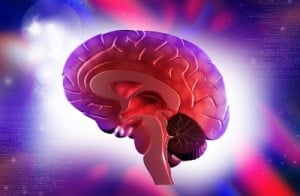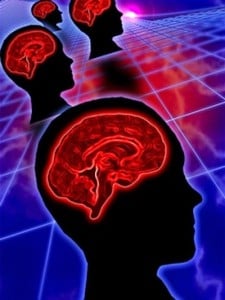Linda B.'s Story
Hurried but not quite awake, Linda B. left her house on a cold, snowy February morning. There was nothing to grasp in her icy driveway, and she fell quickly, unable to break her fall. Dazed, her heart pounding, she crawled to her car and pulled herself to her feet, carefully touching the growing bump above her left ear. The dazed and dizzy sensations, followed by an annoying headache, were reminiscent of an auto accident two years ago. The forty-four year old fifth grade teacher arrived at her classroom and brushed off the bad start to her day.
Although Linda had repeated head injuries, there seemed to be no apparent permanent disruption in brain function. Then, on a bright, colorful summer afternoon at a nearby amusement park, Linda and her son took an exciting ride on the park’s popular roller coaster. Stepping off the ride, Linda felt nauseous, dizzy, and quickly developed a severe unremitting headache. Confusion soon followed.
When autumn arrived and Linda returned to her teaching job, she knew she was in trouble. Half way through the explanation of a math problem, she lost her train of thought and directed her frustration at the students. She had trouble reading. Confusion and crippling headaches made it impossible for her to do her job. Linda took a leave of absence from the teaching she loved.
Brain Injury, One or Many
Often, victims of head trauma like Linda don’t take their injury seriously. Although a single head injury can cause serious brain damage, less severe repetitive head trauma can be cumulative, and can result in serious damage to the brain.
Many doctors assume that the symptoms of brain injury will improve with time. This is not necessarily true. Often, doctors do not recognize the persistent symptoms of brain injury, and do their best to relieve symptoms with medication. Even if these symptoms are thought to be related to brain injury, available treatment options were limited. Today, we know better. An exciting and highly effective treatment is now available for correcting the damage to the brain caused by head injury.
Neuroplasticity
Can an injured brain get rewired? The answer is a resounding yes, thanks to a remarkable characteristic of the brain, called neuroplasticity. Neuroplasticity is the brain’s ability to reorganize itself by creating new neural networks, and it’s ability to rearrange existing connections throughout our lifetime. The brain is usually able to do this unaided in response to new learning experiences, injury or disease, similar to the way our skin heals after a minor cut or scrape. But if the cut is deep or jagged, we need the help of stiches for proper healing. Similarly, the brain can be damaged in a way that it can’t figure out how to fix itself. The brain could use some help.
Neurotherapy
The understanding of neuroplasticity lead brain scientists to discover a new and powerful treatment for brain injury (and other neurological disorders), called neurotherapy. Neurotherapy teaches the brain to make healthy brainwaves by rewarding the brain when the brain waves change towards normalization. Neuroplasticity allows this to happen.
In a typical neurotherapy session, the patient sits in a comfortable reclining chair and watches a computer screen. Sensors are placed on the head and they listen to brain wave activity. No electricity is put into the brain. When the brain makes healthy brain waves, the patient gets a reward by solving a picture puzzle on the computer screen. Repeating this process teaches the brain to make healthy brain waves.
Neurotherapy for Linda
Finding an effective medication proved difficult and frustrating for Linda. Word of Linda’s affliction reached an old friend who had read about a new and exciting treatment with virtually no side effects, meant to create permanent improvement. Linda began neurofeedback, and after six sessions she exclaimed to her son, “I’m back to the real world! I’m now able to focus and maintain my train of thought. I’m getting my memory back.” After 15 sessions, she was thrilled. “I can read again and am loving it. Organization is greatly improved. I’m so relieved,” she exclaimed proudly. At thirty sessions, dramatic improvements in reading, remembering words, and organization made it possible for her to return to teaching without difficulty.
While expressing Linda’s sincere gratitude to her friend, she marveled, “I have joy in my life. I was afraid I never would.” Linda was so impressed by what neurotherapy had done for her, she referred her daughter with ADD and her autistic nephew for neurotherapy treatment, and they too are making wonderful progress!
Extraordinary improvements in brain function rejuvenate the daily lives of the patients and those they love. Thanks to the amazing results from neurofeedback, those suffering from brain injuries finally have hope for recovery.







